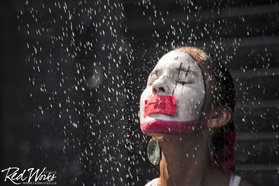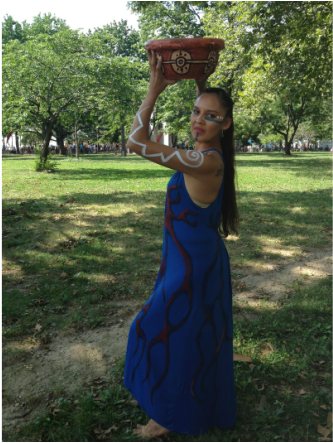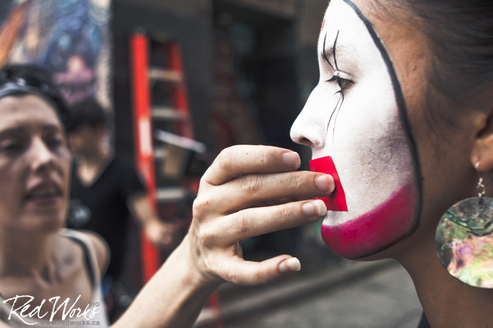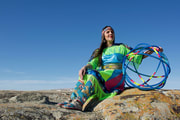Reflecting (on Dance): Dancing Earth brings “Walking at the Edge of Water” to New York City11/4/2013 In July- August 2013 I journeyed to the United States for my fourth time participating in a performance of Walking at the Edge of Water, choreographed by Rulan Tangen of Dancing Earth. We rehearsed in Santa Fe and performed two shows in New York City at the Downtown Dance Festival in Battery Park, sponsored by the Smithsonian Museum of the American Indian. There were ten dancers in the ensemble, and five of them I have worked with before (including Rulan) and it is always such an awesome experience to work with other Indigenous dancers. I would have to say this group is one of the best I have ever worked with, all being professional dancers, as well as, holders of traditional and spiritual knowledge and tradition. The way these dancers were brought together was nothing short of the universe flowing together in harmony. I believe we worked very well together and as a result were let out of rehearsal early on several occasions! (This in my experience is very rare) There were many instances where we came across signs that confirmed to us as a group and as individuals that we were meant to be here. We were destined to represent Indigenous dance next to dance companies from around the world, including NYC’s prestigious José Limón Company.
One of the first things we did upon arrival in NYC (after a red eye flight and a 6:00 am arrival) was visit the Two Row Wampum Gathering, which seeks honor for the original intention of the treaties, such as peace and sovereignty. The day before our arrival there was a march to the United Nations with hundreds of people who paddled canoes into NYC harbor in order to bring the message of the Two Row Wampum. The Two Row Wampum itself, which I had learnt about as a Graduate student with Dr. David Newhouse, represents two canoes paddling side by side along a river, neither interfering with the other’s vessel, but co-existing peacefully. This ideal had many implications and undertones relevant to our dance for the water. The river, canoes, peace and sovereignty is representative of many of the issues different Indigenous dancers have brought up over the years during the different explorations of Walking at the Edge of Water. When we arrived at the gathering we heard the Akwesasne Women Singers share a song for the water and the connection between women, birth and water. This is a theme we had heard from Anishnaabeg (Ojibway) women in Peterborough, Ontario during one of the first explorations creating dance around the theme of water. This was reflected for me in the fact that I was 15 weeks pregnant when we arrived in NYC, so my participation in Walking at the Edge of Water was especially compelling. In Anishnaabeg teachings water is also associated with emotions, such as those expressed through tears. I have been known to cry real tears on stage and backstage because of the emotional power in this dance. For me this was one of the most emotionally powerful performances of this show. Some of the Chiefs at the gathering spoke about the importance of water, and urged us to be aware of our impact on the water. An imminent and potent message as we sat next to the harbor where the canoes had paddled in and near the site where we would be dancing the next day to bring awareness to the issue. This was reflected in our performance through many images that depicted the harmful effects our actions have on water and the environment, such as oil, vanity, greed, and consumption. In a recent professional development opportunity, training in the’7 Habits of Highly Effective People’ we learnt about empathy. What we were taught was that reflecting is one of the highest forms of empathetic listening. The best way to show empathy towards others is reflecting back to them their words, thoughts and feelings. In this way we do not make assumptions, place judgement or focus on ourselves. We are simply reflecting what we hear or see. For me this resonated with my experiences in Walking at the Edge, of Water throughout this piece the dancers simply reflect... Reflecting water itself, reflecting Indigenous stories and teachings around water, reflecting how we all contribute to the destruction of water, reflecting the sacredness of water and the healing of water, thereby demonstrating the greatest form of empathy, one that makes no judgement or assumptions… And if the title of the training is accurate this is a ‘highly effective’ way to bring awareness to and show empathy for the sacred waters 'of our bodies and of the earth’ (as Rulan would say). We can only hope that this passion for the environment will continue to be reflected back to us through the people we meet, leaders that speak out, women that sing for the water, and is joined by the actions and voices of many more… Currently, I feel a great sense of pride as I follow Dancing Earth: Indigenous Contemporary Dance Creations on their tour to New Zealand, bringing this important dance and message to the world. You can read more about this journey at www.dancingearth.org or follow them on Facebook or Twitter. My participation was funded by the Canada Council for the Arts. Dancing Earth's U.S. dancers sponsored by the Smithsonian Museum of the American Indian in NYC.
2 Comments
 This week is the premiere of “When It Rains” a one-minute silent film commissioned by imagineNATIVE’s Stolen Sisters Digital Initiative. The film can be seen October 15-21, 2012 at locations across Canada including Edmonton, Calgary, Victoria, Vancouver, Winnipeg, Halifax, Toronto and Ottawa. The film was Co-created by award winning Director, Cara Mumford and Dancer and Choreographer, Sandra Lamouche; Guest Choreographer (hip hop), Sugarray Robinson (Toronto, ON); and Guest Choreographer (Indigenous Contemporary), Rulan Tangen (Santa Fe, NM). The film combines hoop dance and hip hop to, “represent the collective journey of the hundreds of missing and murdered Indigenous women in Canada. While each of these women’s stories is unique, they share a commonality in their collective experience of identity loss and voices silenced” (Cara Mumford, Project Description of ‘When it Rains’). It has been almost ten years since I first heard about the Stolen Sisters and started to get involved. My first time advocating for the Stolen Sisters was sitting at a table by myself in the University of Lethbridge atrium during one of the Native Awareness Week events in 2003. I printed off the petition and information and collected signatures from students and staff. A year or so later I was invited to the Lethbridge Public Library to be a part of a panel discussion for the film about one of our missing sisters called ‘Finding Dawn’. I remember saying that if Aboriginal women were to be protected and acknowledged as having human rights then we would also have to acknowledge treaty rights, which include the rights to our land and resources, something I believe stands in the way of treating Indigenous peoples everywhere as human beings. A few years later, wanting to learn more about my family history, I asked my mother what happened to my kokum (my grandmother), her mother. She told me the story of my kokum Sarah Cardinal and how she had been hit by a drunk driver and her body thrown into the lake, she was later found frozen. This happened over fifty years ago and is still an unsolved murder case. In 2006 my youngest sister Julie Lamouche went missing from our home in Lethbridge, Alberta for about one month. She was with an abusive and controlling boyfriend who would take her different places without telling her or anyone else where they were going. Thanks to the guidance of a medicine man in Saskatchewan and my auntie’s spiritual gifts she was found near Edmonton, Alberta. That fall I attended the first annual Lethbridge Sisters in Spirit Candlelight Vigil. These two stories tell the worst case and best case scenarios for Aboriginal women who go missing in Canada. For my kokum, as an unsolved murder case I believe that the police have not done enough to bring justice to her murderer(s). In my sister’s case, again, the police actually did very little to help find her. It was my parents and family who searched for her. It was because of the spiritual help that we knew where to look for her in the first place. In June and July 2012 I began rehearsals and filming of ‘When it Rains’ which forced me to re-live the anger, hurt, worry and frustration from my kokum and sister’s story. This allowed me to re-evaluate the situation of the Stolen Sisters campaign, Aboriginal women, my community, family and myself. For the first scene I did a traditional hoop dance in a traditional Cree dress as I thought of my mother and how her actions and words embody so much of what our traditional roles as women in Cree culture is all about. How spiritual connectedness and prayer is such a major part of her life and how I aim to be as peaceful and grounded as she is. The second scene was the hip hop choreography which represented the pressures of mainstream society on Aboriginal women, such as glass ceilings, systemic racism, oppression and stereotypes. Here I thought of the injustice of my kokum and my sister and their experiences. This helped me to tap into the anger and frustration surrounding the issues faced by Aboriginal women. The third scene was the rain which washed away the negative (represented by statistics written on my arm and hand) and symbolized healing. This was followed by the ‘fusion’ look which combined hip hop and hoop dance styles together. This represented the ability for Aboriginal women to live in both contemporary and traditional worlds and maintain healthy and balanced lifestyles. I was not only empowered by the women in my family and other women around me (such as Cara and Rulan) but also by being able to spread awareness, understanding and inspiration to others as well. In the final scene I set forth my intention for the future, my own and future generations, to move forward on the path towards healing and well being. In August 2012 while in Vancouver I was able to attend a gathering on the Downtown Eastside one of the main areas of focus for the Stolen Sisters and Sisters in Spirit. Here I witnessed one of the largest gatherings I have attended for the cause. I witnessed group choreography by the Butterflies in Spirit. A group of 12 Aboriginal women in Vancouver who create dance performances dedicated to, “...raising awareness about violence against aboriginal women, remembering and honoring missing and murdered aboriginal women and girls across Canada, promoting positive role models, aiming to provide advocacy and support services for the families of missing women” (Butterflies in Spirit). They performed a powerful piece that honored the missing and murdered Aboriginal women using both traditional and contemporary song, dance and imagery. On October 4, 2012 my sister Maria and I volunteered for the Sisters in Spirit Candlelight Vigil in Lethbridge, Alberta to honor our kokum Sarah and all the missing and murdered Aboriginal women in Canada. After all these years, all that I have learnt and all that my family has gone through it was a very emotional day for me. I found myself smudging by noon that day because of the intense emotions I was feeling... wishing I could have met my kokum, thankful my sister was found safe, all the stories and statistics, how awe inspiring the Aboriginal women in my life are and how little recognition they get. It was a chilly evening and as I danced I began to lose feeling in my fingers ‘how am I going to do this?’ I thought; which was immediately followed by a thought of my kokum Sarah and her frozen body. I thought, ‘I’m doing this for her’. I was thankful to have my spirituality as recourse for the intensity of the day. My prayers, hopes, dreams and perseverance serves as a silver lining to the oppression of Aboriginal women, and I believe that our ancestors would want us to always look for that silver lining. My mother, knowing how it was to grow up without a mother of her own, did everything she could and more to provide us with a safe, happy and healthy environment to grow. My sister, now a mother of a beautiful toddler boy is in college and a life coach, promoting healthy lifestyles. We are all moving forward together... towards healing and well being. Kisaageetin... You are loved by me. imagineNATIVE's Stolen Sisters Digital Initiative http://imaginenative.org/festival2012/SSDI Cara Mumford’s blog post on the making of ‘When it Rains’ http://www.imaginenative.org/wordpress/2012/08/when-it-rains-by-cara-mumford/ Amnesty International- Stolen Sisters http://www.amnesty.ca/atrisk/index.php/stolen-sisters-2/ Native Women’s Association of Canada- Sisters In Spirit http://www.nwac.ca/programs/sisters-spirit Photos by Nadya Kwandibens, Red Works Studio |
Nehiawsko Pikiskwew'Cree Woman Speaking' is a space to share my voice. My goal is to spread awareness and share wisdom as I learn and grow as a dancer, choreographer, and woman. My passion is to show the healing power of dance and culture. I love learning from elders, experience, and research and being able to synthesize Native and non-Native ways of knowing! Archives
November 2023
Categories
All
|


